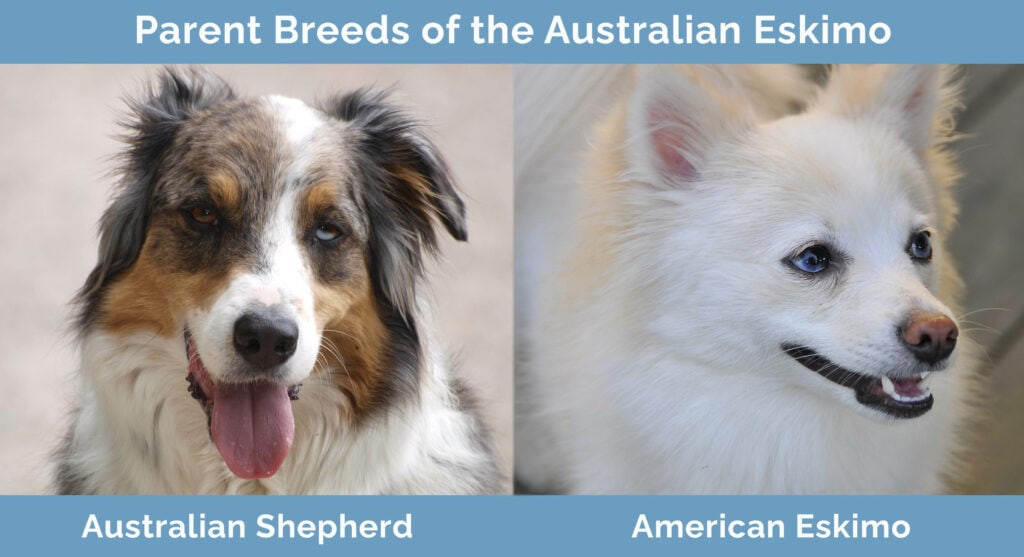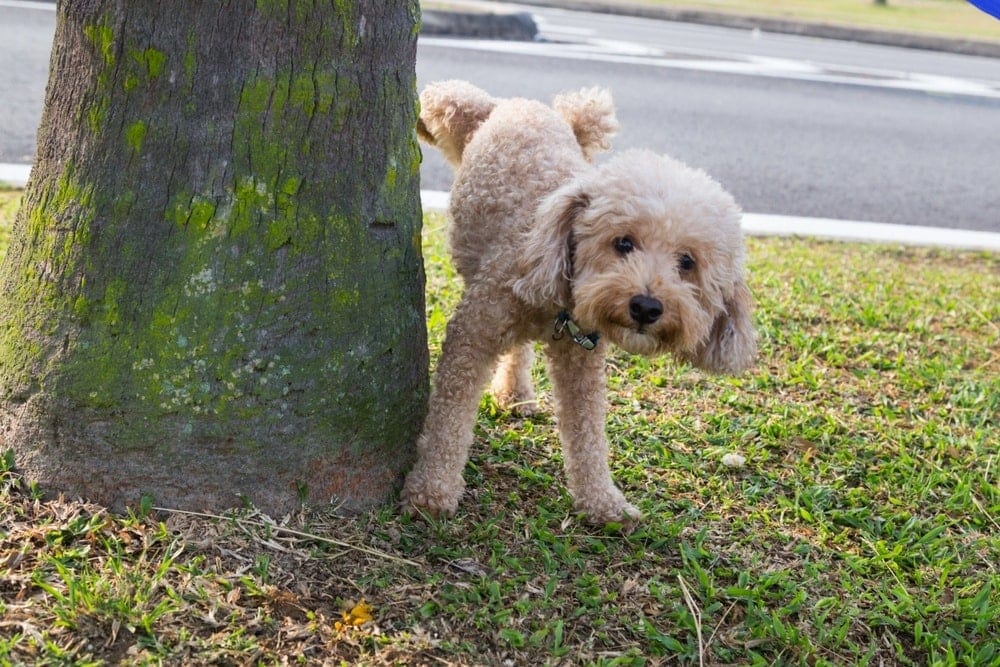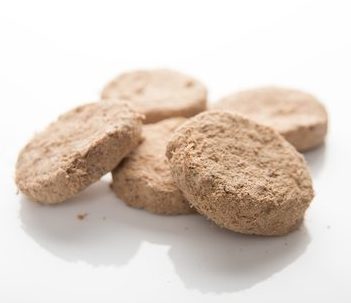Australian Eskimo (American Eskimo & Australian Shepherd Mix): Pictures & Info

Updated on

| Height: | 19 – 23 inches |
| Weight: | 35 – 52 pounds |
| Lifespan: | 12 – 15 years |
| Colors: | White, black, and brown |
| Suitable for: | Active families with kids, energetic people with fenced-in yards |
| Temperament: | Intelligent, active, friendly, loyal, affectionate, and loving |
If you have been searching for an active, friendly, and affectionate puppy to join your family, the Australian Eskimo may be the right dog for you. This is a designer hybrid that is bred from an American Eskimo and an Australian Shepherd. They make great companion dogs and do well in a family environment.
As a designer breed, the Australian Eskimo is a mix of an American Eskimo and an Australian Shepherd. Typically, hybrids are created to combine the best traits of their parents. Breeders are also hoping to make a healthier canine than their purebred ancestors.
Like most of these mixed pups, there has not been a lot of documented research on this pup. On the other hand, you can gain quite a bit of knowledge about them based on their background. For example, we know this dog is playful, affectionate, loyal, and a bit toothy as a puppy. Also called the Aussie Eskimo, they will be a handful when they are small. Of course, their antics and playfulness will keep you laughing and sighing over their cuteness.
Australian Eskimo Puppies
You have the option of looking for this hybrid through rescue shelters. Unfortunately, you will likely not receive a lot of background info on the dog as most of them are surrendered without a lot of details. On the other hand, rescue shelters typically ensure they are up to date on shots and other medical needs.
Shelters also have a lower adoption fee and this money is usually put toward the care and rescue of other animals. Keep in mind, however, as this breed is not as common, you may have to wait a considerable amount of time before there is one available. It never hurts to check, though.
If you are purchasing your pup, after the initial fee, there are other expenses you should be aware of before adopting any pet. For example, you will need to get your puppy their shots, check-ups, neutering/spaying services, and microchipping. There is also the matter of essentials like food, leashes, bedding, flea and tick treatments, grooming supplies, and much more.
All of these items are pretty standard, and most pet parents are aware of them. Some other unforeseen costs can take you by surprise, however. For example, some states and towns require you to have a license for your dog that will need to be renewed annually. You could also need items like indoor fencing or professional grooming assistance.
Either way, you should have these expenses in mind in case they become necessary in the future.
 3 Little-Known Facts About the Australian Eskimo
3 Little-Known Facts About the Australian Eskimo
1. They have interesting coat colors.
The Aussie Eskimo is typically white with either brown or black spots. They can have a speckled or merle pattern, as well.
2. Australian Shepherds are from…
Contrary to their name, the Australian Shepherd originated in the United States in the 1840s to herd livestock.
3. American Eskimos are from…
Also contrary to their name, the American Eskimo is not indeed from American. They originated in German as part of the Spitz canine family.

Temperament & Intelligence of the Australian Eskimo 🧠
The Aussie Eskimo is a companion dog that is affectionate, friendly, and active. With high intelligence, they are quick to pick up on things that will make you smile. Their main goal is to please you, plus they are very loyal to their pet-parents with an alert and agile nature.
These friendly dogs are also large in size. If you are unfamiliar with them, they may seem tough, fierce, and a bit scary. In reality, they are a non-aggressive pet that is kind and gentle. They also do not make much of a watchdog. They are not likely to bark at strangers, and a treat with a compliment will get you invited right inside. Be that as it may, both of this pup’s parents have a prey drive that was passed down to this hybrid.
You should also keep in mind that this big fur ball is very active. Not only will they want to go on all outdoor adventures, but they also do well with some mental stimulation. This is a pet that is not likely to throw a tantrum if left alone, but they thrive in a family setting. Even if you are a single household, you will notice they are at their happiest when they are with you the majority of the time.
Are These Dogs Good for Families? 🏡
The Aussie Eskimo makes a great family dog. They are great with children of all ages, and they will chase after them all day. This is handy because this pup needs a lot of exercise. Keeping up with the kids is a great way to keep them happy. As with any big dog, though, you want to teach your kids how to interact with the dog correctly. Accidents can happen, so monitoring very young children is recommended.
Does This Breed Get Along with Other Pets? 🐶 😽
You will also find this dog gets along well with other animals and pets in the home. They will quickly make friends with other canines at the dog park, and they will share toys and games with other dogs in your home.
They also do well with smaller animals like cats. Again, the Aussie Eskimo has a strong prey drive, so you may notice them chasing squirrels in the yard or even birds. For the most part, they are not doing so aggressively as much as they want to herd and run.
These behaviors are all dependent on their early socialization training, however. On the whole, this breed is friendly, social, gentle, and intelligent. They are unlikely to bite, be aggressive towards other people or animals, or even bark. If they are not introduced to people and other animals at a young age, though, they might not be as well adjusted.
Things to Know When Owning an Australian Eskimo
If you were already considering adopting an Australian Eskimo, the above info has probably made you even more confident in your decision. Who doesn’t want a friendly, affectionate, and active pup that is great with kids, and you can bring almost anywhere without incident? Perfect, right? Not so fast…
Although this canine has many stellar qualities, there are still a lot of aspects of their care we have to discuss. Pet adoption should always be done with a mind to not only your desires but the animal’s well-being, too. Even if they are perfect for you, you may not be perfect for them.
Food & Diet Requirements 🦴
One common misconception that pet-parents have is that their pet’s diet is the easiest thing to handle. If you have never had a pooch with meal-maladies then it is understandable to have these thoughts, but it is not usually the case. Even if your pet has no dietary restrictions, you must provide them with the best formula for their age, lifestyle, and health.
The Australian Eskimo is a large-sized dog that is very active. They should be given food with healthy levels of protein, fat, and fiber. They also have a thick coat of fur and can suffer from joint pain later in life, so you should also look for meals with fish oil, omega fatty acids, glucosamine, etc.
You will also want to pick foods that are appropriate for your pet’s age. They will require different ingredients when they are a puppy versus when they are in mid-life. Seniors also need specific nutrients and vitamins.
One thing to note about the Aussie Eskimo is they are prone to allergies. Though the food may not always be the culprit, you should keep your eye on them for skin rashes, stomach upsets, excess gas, and itchy eyes and ears. Additionally, you should speak to your vet about your dog’s meal plan. They will be able to give you details on what your pet should eat for their specific needs.
Exercise 🐕
Adequate exercise is a very important aspect of this breed’s care. They need to stretch their legs via a walk twice a day for at least 30 minutes. They will also need some additional fun time in the backyard or dog park. Generally, the Aussie Eskimo will do the best in a house with a fenced-in yard.
That being said, this pup can thrive in an apartment or condo setting with the right pet-parent. Someone who is home often and enjoys a lot of activity is crucial for their well-being. They are also comfortable in all temperatures whether cold or hot. Regardless of their home life, however, boredom and inactivity are not good for this hybrid. They can become destructive and depressed. They may chew on furniture, dig, or bark, plus other behaviors that are not good for them or you.
Besides their physical activity needs, they also require mental stimulation. This designer breed comes from a long line of working dogs that have the smarts to be very good at their jobs. Therefore, this pup will thank you for games, learning tricks, agility courses, and other fun stuff you can do together.
Training 🦮
Going back to their intelligence, the Aussie Eskimo is well able to learn behavioral, obedience, and socialization skills. Unfortunately, it can be a long process. Though they can have a stubborn streak, this pooch is more interested in having a good time than learning “serious lessons.”
The best way to handle this hurdle is by taking your time, keeping it short and fun, and above all, being patient. Persistence and consistency are the two pillars of a well-trained Australian Eskimo.
You should also note that this breed does great with positive reinforcement. Giving them a treat after they sit, stay, on come will be worth it. Overall, this pup is eager to please. They will take your lead on how to behave and react. It is important not to be aggressive or get too frustrated, as well. It’s okay to break and pick it up tomorrow.
Lastly, you want to start training your Australian Eskimo as early as possible. Here are some basic training needs that should be started as early in their puppy years as possible.
- Behavioral: Teaching your pup not to chew on shoes, bark, sleep in their crate, etc. is important for their overall mindset in your home. You want to keep these lessons short and fun with plenty of treats and praise when they do well. You also want to give them alternative behaviors. For example, giving them a chew toy so they don’t go after your shoes, and providing them a bed to sleep on so they won’t hop on the couch.
- Obedience: This training is very important for their well-being and safety. These are the commands that can take more time: sit, stay, heel, stop, come, etc. You will want to practice obedience on a training leash as much as possible. Again, positive reinforcement is important. Dominating your pet, on the other hand, will only make them more resistant.
- Housebreaking: No one wants to wake up to puppy puddles, right? Thankfully, this is one of the easier skills for this breed to learn. You want to find your “command phrase” like “potty” or “bathroom” and begin to use them when bringing your pup outside. You will also want to bring them to the same spot every day. If you are using puppy pads, move it closer to the door every day, until it’s finally outside.
- Socialization: Socialization is essential for a well-rounded dog, and it is the one training that requires the least amount of input on your part. In this case, you should allow your pet to be introduced to as many new people, pets, smells, sounds, and sights as possible. Take them to the dog park, to the pet store, introduce them to friends, and the neighborhood cat. The better socialized they are, the friends they will be in their adulthood.
Grooming ✂️
The Australian Eskimo has longer fur that is coarse and fluffy. They will need to be brushed at least two times a week to keep the excess fur at bay and to also prevent mats from forming. Typically, this breed is not a high shedder, but if you do not take care of their coat, things can escalate to professional cleaning quickly!
There will also be times when their coat needs a little extra TLC. For example, when they shed their winter and summer fur, you will want to up the brushing from twice a week to five times per week. They can also benefit from a trim in the summer to keep their fur healthy. This will also help keep ticks and flea treats work properly.
When it comes to baths, you should do so on an as-needed basis. Bathing them too often can strip their fur of its natural oils that keep the hairs strong, healthy, and shiny. If you do need to scrub your smelly pooch, make sure you use a gentle canine shampoo as they can have allergies. Also, be sure to dry them as well as you can.
Other Grooming Needs
Once you have your Australian Eskimo’s coat care down pat, you also have to think about their teeth, nails, and ears. First, their nails should be trimmed every three to five weeks depending on their activity level. The more outdoor activity they have, the longer they can go without needing a pedicure. Just keep in mind, if you can hear their nails on the floor, they are too long.
The Aussie Eskimo’s ears should be checked every few days for signs of irritation, redness, excess wax, and mites. Once a week, you will want to gently wipe down their inner ear with a canine ear wash solution. A cotton ball or pad works best, but you can also use a soft face cloth.
Finally, teeth. Unfortunately, the Australian Eskimo’s teeth require a lot of care. The breed is prone to dental issues, so brushing as often as possible is important. It is understandable, however, that daily brushing can be tough. Trying to do it as often as possible, plus giving them dental treats is essential for reducing tartar and plaque build-up. As we will discuss more in the next section, annual check-ups are also important. Your vet will inspect their teeth and ears (among other areas) for signs of trouble.
Health and Conditions ❤️
The Australian Eskimo is a fairly healthy pooch, however. Below, we have outlined the different issues that could arise broken into serious and minor concerns. Keep in mind, some of the minor issues are serious conditions, but are less likely to occur. As always, it’s important to get your dog regular vet check-ups to make sure they are healthy and happy.
- Allergies
- Dental disease
- Epilepsy
- Addison’s disease
- Patellar luxation
- Progressive retinal atrophy
- Hip dysplasia
Conclusion
The Australian Eskimo is an intelligent, happy, and loyal dog that makes a great companion for families with kids, other pets, or a single person. They are energetic, love to play games, and learn tricks. You will find a furbaby that is happy to be by your side and make a few friends along the way. Overall, this is a pet that is fairly easy to take care of as long as you have the love and patience needed to ensure they are happy and healthy.
We hope you have enjoyed this article, and it has given you all the info you need to decide on whether or not an Australian Eskimo is right for you. Pet ownership is a big responsibility, but it comes with many rewards. Your only job is to ensure that not only is this pet a good fit for you but that you are right for them!
Featured Image Credit: Jumpstory

 3 Little-Known Facts About the Australian Eskimo
3 Little-Known Facts About the Australian Eskimo











